Assessment and Care of a Patient with Chronic Bronchitis and Emphysema
VerifiedAdded on 2023/06/09
|10
|3231
|333
Report
AI Summary
This report presents a comprehensive analysis of the clinical care provided to a 78-year-old patient, Mrs. Smith, suffering from severe chronic bronchitis and emphysema. The report begins with a detailed discussion of the primary and secondary assessment methods, including the assessment of vital signs such as respiratory rate, SpO2, heart rate, blood pressure, and temperature. It outlines the expected findings during the assessment, such as respiratory distress, decreased breath sounds, and increased heart rate, and discusses appropriate emergency interventions. The interventions include oxygen therapy, intubation, administration of beta-agonists and anticholinergics, and the use of CPAP or BiPAP. Furthermore, the report explores the physiological changes associated with chronic bronchitis and emphysema, including impaired airways, reduced elasticity of alveoli, and the impact on gas exchange. The report also examines the use of different oxygen delivery methods. The report integrates workplace policies and procedures, providing a practical guide to managing patients with severe COPD.
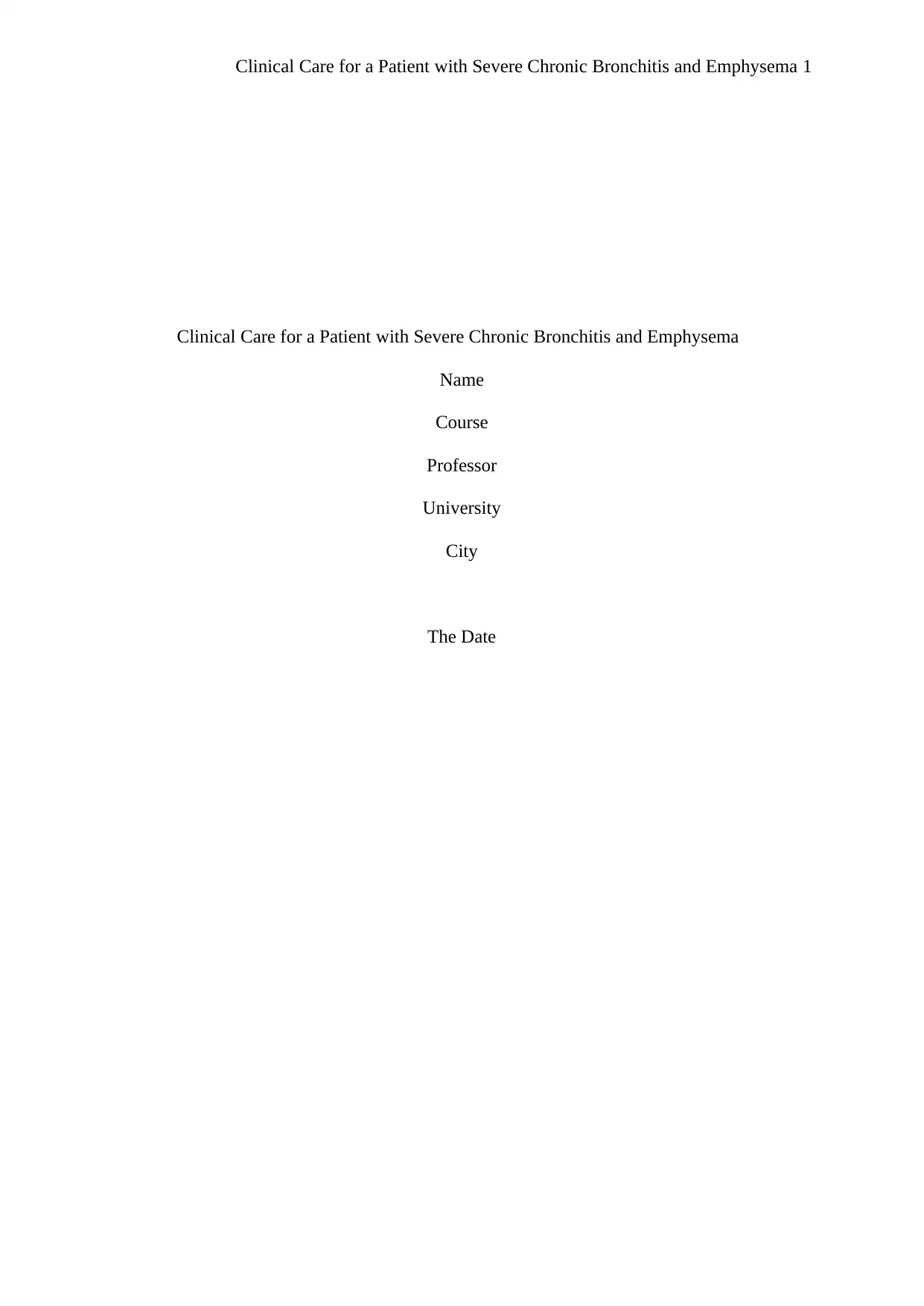
Clinical Care for a Patient with Severe Chronic Bronchitis and Emphysema 1
Clinical Care for a Patient with Severe Chronic Bronchitis and Emphysema
Name
Course
Professor
University
City
The Date
Clinical Care for a Patient with Severe Chronic Bronchitis and Emphysema
Name
Course
Professor
University
City
The Date
Paraphrase This Document
Need a fresh take? Get an instant paraphrase of this document with our AI Paraphraser
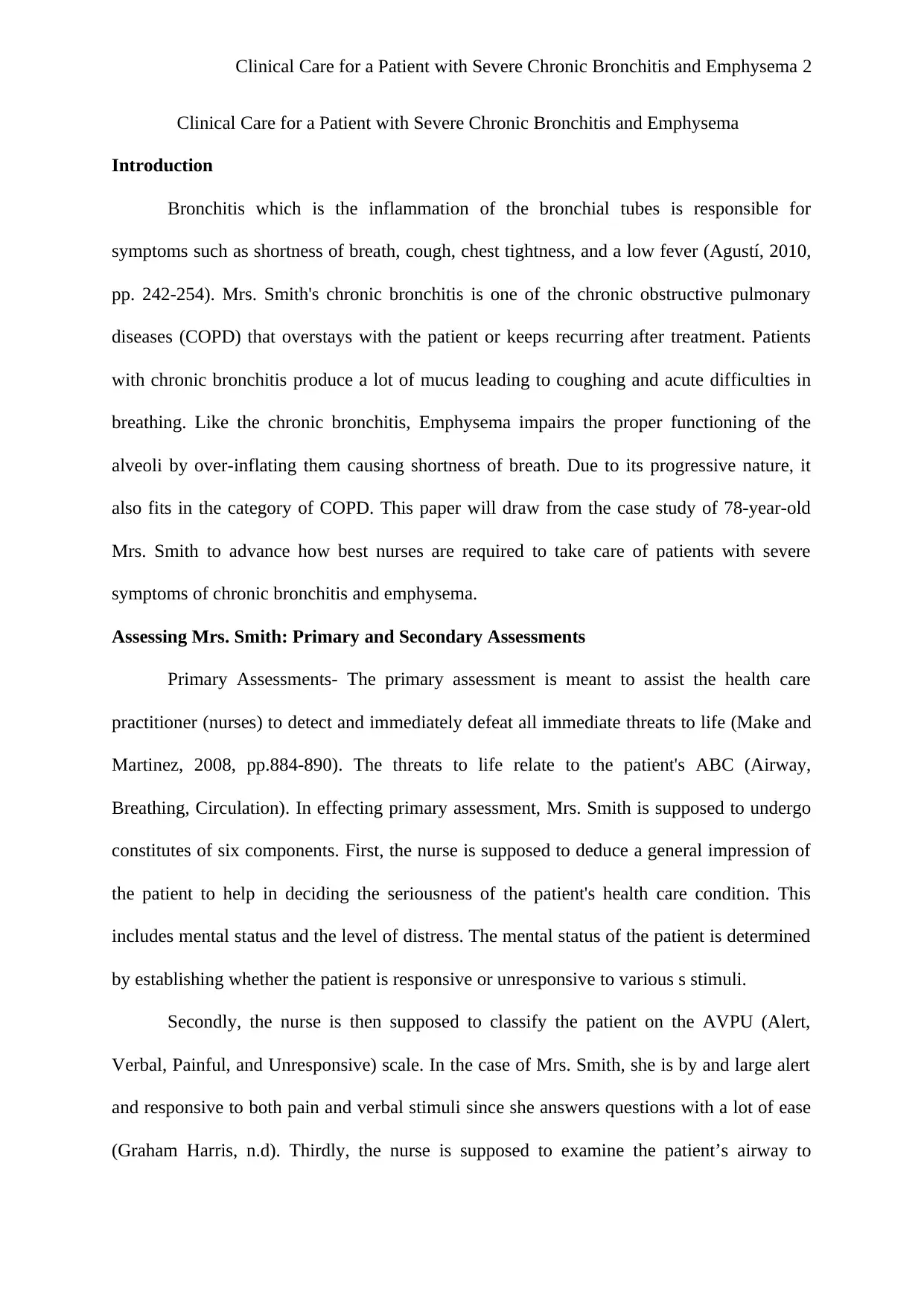
Clinical Care for a Patient with Severe Chronic Bronchitis and Emphysema 2
Clinical Care for a Patient with Severe Chronic Bronchitis and Emphysema
Introduction
Bronchitis which is the inflammation of the bronchial tubes is responsible for
symptoms such as shortness of breath, cough, chest tightness, and a low fever (Agustí, 2010,
pp. 242-254). Mrs. Smith's chronic bronchitis is one of the chronic obstructive pulmonary
diseases (COPD) that overstays with the patient or keeps recurring after treatment. Patients
with chronic bronchitis produce a lot of mucus leading to coughing and acute difficulties in
breathing. Like the chronic bronchitis, Emphysema impairs the proper functioning of the
alveoli by over-inflating them causing shortness of breath. Due to its progressive nature, it
also fits in the category of COPD. This paper will draw from the case study of 78-year-old
Mrs. Smith to advance how best nurses are required to take care of patients with severe
symptoms of chronic bronchitis and emphysema.
Assessing Mrs. Smith: Primary and Secondary Assessments
Primary Assessments- The primary assessment is meant to assist the health care
practitioner (nurses) to detect and immediately defeat all immediate threats to life (Make and
Martinez, 2008, pp.884-890). The threats to life relate to the patient's ABC (Airway,
Breathing, Circulation). In effecting primary assessment, Mrs. Smith is supposed to undergo
constitutes of six components. First, the nurse is supposed to deduce a general impression of
the patient to help in deciding the seriousness of the patient's health care condition. This
includes mental status and the level of distress. The mental status of the patient is determined
by establishing whether the patient is responsive or unresponsive to various s stimuli.
Secondly, the nurse is then supposed to classify the patient on the AVPU (Alert,
Verbal, Painful, and Unresponsive) scale. In the case of Mrs. Smith, she is by and large alert
and responsive to both pain and verbal stimuli since she answers questions with a lot of ease
(Graham Harris, n.d). Thirdly, the nurse is supposed to examine the patient’s airway to
Clinical Care for a Patient with Severe Chronic Bronchitis and Emphysema
Introduction
Bronchitis which is the inflammation of the bronchial tubes is responsible for
symptoms such as shortness of breath, cough, chest tightness, and a low fever (Agustí, 2010,
pp. 242-254). Mrs. Smith's chronic bronchitis is one of the chronic obstructive pulmonary
diseases (COPD) that overstays with the patient or keeps recurring after treatment. Patients
with chronic bronchitis produce a lot of mucus leading to coughing and acute difficulties in
breathing. Like the chronic bronchitis, Emphysema impairs the proper functioning of the
alveoli by over-inflating them causing shortness of breath. Due to its progressive nature, it
also fits in the category of COPD. This paper will draw from the case study of 78-year-old
Mrs. Smith to advance how best nurses are required to take care of patients with severe
symptoms of chronic bronchitis and emphysema.
Assessing Mrs. Smith: Primary and Secondary Assessments
Primary Assessments- The primary assessment is meant to assist the health care
practitioner (nurses) to detect and immediately defeat all immediate threats to life (Make and
Martinez, 2008, pp.884-890). The threats to life relate to the patient's ABC (Airway,
Breathing, Circulation). In effecting primary assessment, Mrs. Smith is supposed to undergo
constitutes of six components. First, the nurse is supposed to deduce a general impression of
the patient to help in deciding the seriousness of the patient's health care condition. This
includes mental status and the level of distress. The mental status of the patient is determined
by establishing whether the patient is responsive or unresponsive to various s stimuli.
Secondly, the nurse is then supposed to classify the patient on the AVPU (Alert,
Verbal, Painful, and Unresponsive) scale. In the case of Mrs. Smith, she is by and large alert
and responsive to both pain and verbal stimuli since she answers questions with a lot of ease
(Graham Harris, n.d). Thirdly, the nurse is supposed to examine the patient’s airway to
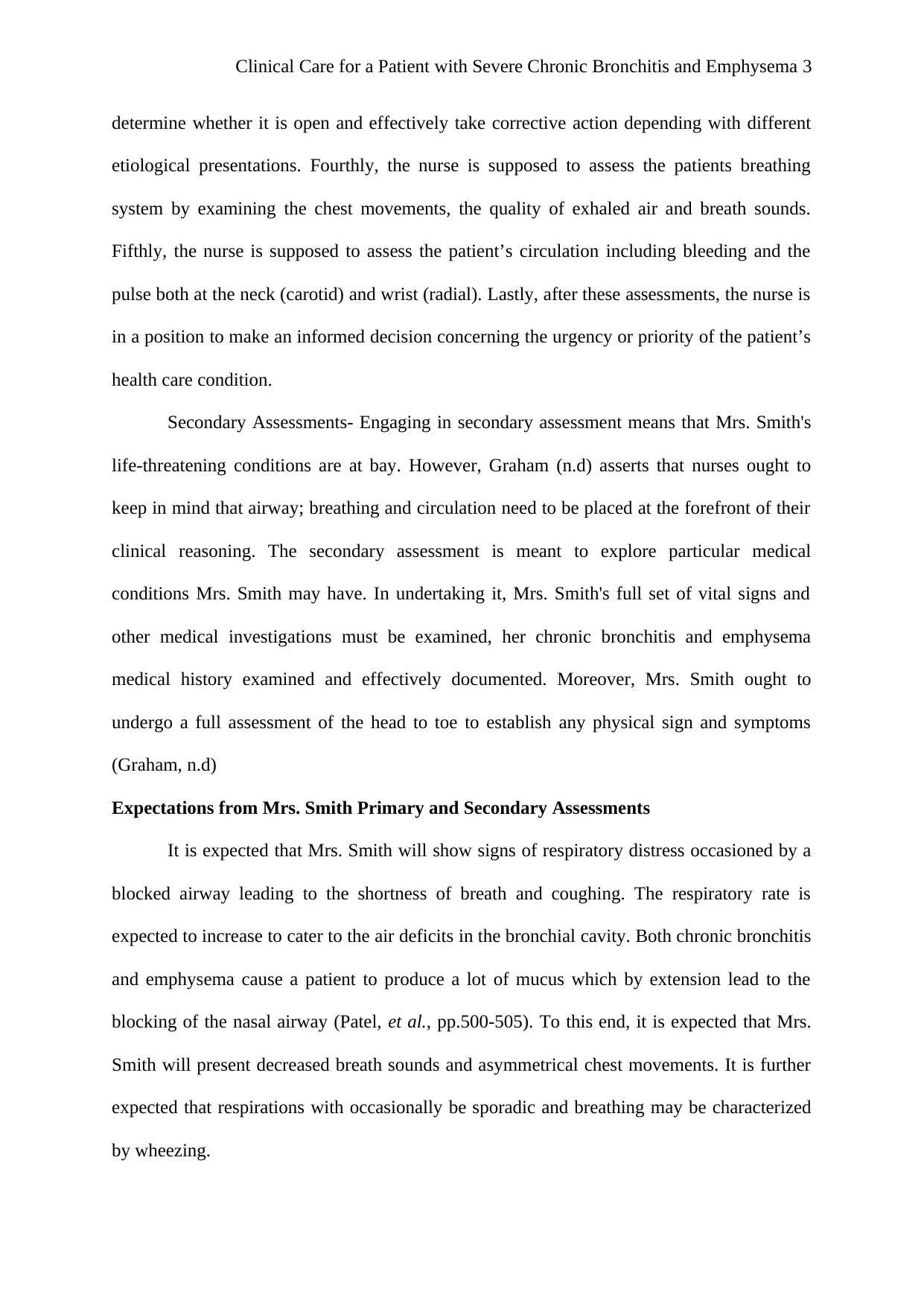
Clinical Care for a Patient with Severe Chronic Bronchitis and Emphysema 3
determine whether it is open and effectively take corrective action depending with different
etiological presentations. Fourthly, the nurse is supposed to assess the patients breathing
system by examining the chest movements, the quality of exhaled air and breath sounds.
Fifthly, the nurse is supposed to assess the patient’s circulation including bleeding and the
pulse both at the neck (carotid) and wrist (radial). Lastly, after these assessments, the nurse is
in a position to make an informed decision concerning the urgency or priority of the patient’s
health care condition.
Secondary Assessments- Engaging in secondary assessment means that Mrs. Smith's
life-threatening conditions are at bay. However, Graham (n.d) asserts that nurses ought to
keep in mind that airway; breathing and circulation need to be placed at the forefront of their
clinical reasoning. The secondary assessment is meant to explore particular medical
conditions Mrs. Smith may have. In undertaking it, Mrs. Smith's full set of vital signs and
other medical investigations must be examined, her chronic bronchitis and emphysema
medical history examined and effectively documented. Moreover, Mrs. Smith ought to
undergo a full assessment of the head to toe to establish any physical sign and symptoms
(Graham, n.d)
Expectations from Mrs. Smith Primary and Secondary Assessments
It is expected that Mrs. Smith will show signs of respiratory distress occasioned by a
blocked airway leading to the shortness of breath and coughing. The respiratory rate is
expected to increase to cater to the air deficits in the bronchial cavity. Both chronic bronchitis
and emphysema cause a patient to produce a lot of mucus which by extension lead to the
blocking of the nasal airway (Patel, et al., pp.500-505). To this end, it is expected that Mrs.
Smith will present decreased breath sounds and asymmetrical chest movements. It is further
expected that respirations with occasionally be sporadic and breathing may be characterized
by wheezing.
determine whether it is open and effectively take corrective action depending with different
etiological presentations. Fourthly, the nurse is supposed to assess the patients breathing
system by examining the chest movements, the quality of exhaled air and breath sounds.
Fifthly, the nurse is supposed to assess the patient’s circulation including bleeding and the
pulse both at the neck (carotid) and wrist (radial). Lastly, after these assessments, the nurse is
in a position to make an informed decision concerning the urgency or priority of the patient’s
health care condition.
Secondary Assessments- Engaging in secondary assessment means that Mrs. Smith's
life-threatening conditions are at bay. However, Graham (n.d) asserts that nurses ought to
keep in mind that airway; breathing and circulation need to be placed at the forefront of their
clinical reasoning. The secondary assessment is meant to explore particular medical
conditions Mrs. Smith may have. In undertaking it, Mrs. Smith's full set of vital signs and
other medical investigations must be examined, her chronic bronchitis and emphysema
medical history examined and effectively documented. Moreover, Mrs. Smith ought to
undergo a full assessment of the head to toe to establish any physical sign and symptoms
(Graham, n.d)
Expectations from Mrs. Smith Primary and Secondary Assessments
It is expected that Mrs. Smith will show signs of respiratory distress occasioned by a
blocked airway leading to the shortness of breath and coughing. The respiratory rate is
expected to increase to cater to the air deficits in the bronchial cavity. Both chronic bronchitis
and emphysema cause a patient to produce a lot of mucus which by extension lead to the
blocking of the nasal airway (Patel, et al., pp.500-505). To this end, it is expected that Mrs.
Smith will present decreased breath sounds and asymmetrical chest movements. It is further
expected that respirations with occasionally be sporadic and breathing may be characterized
by wheezing.
⊘ This is a preview!⊘
Do you want full access?
Subscribe today to unlock all pages.

Trusted by 1+ million students worldwide
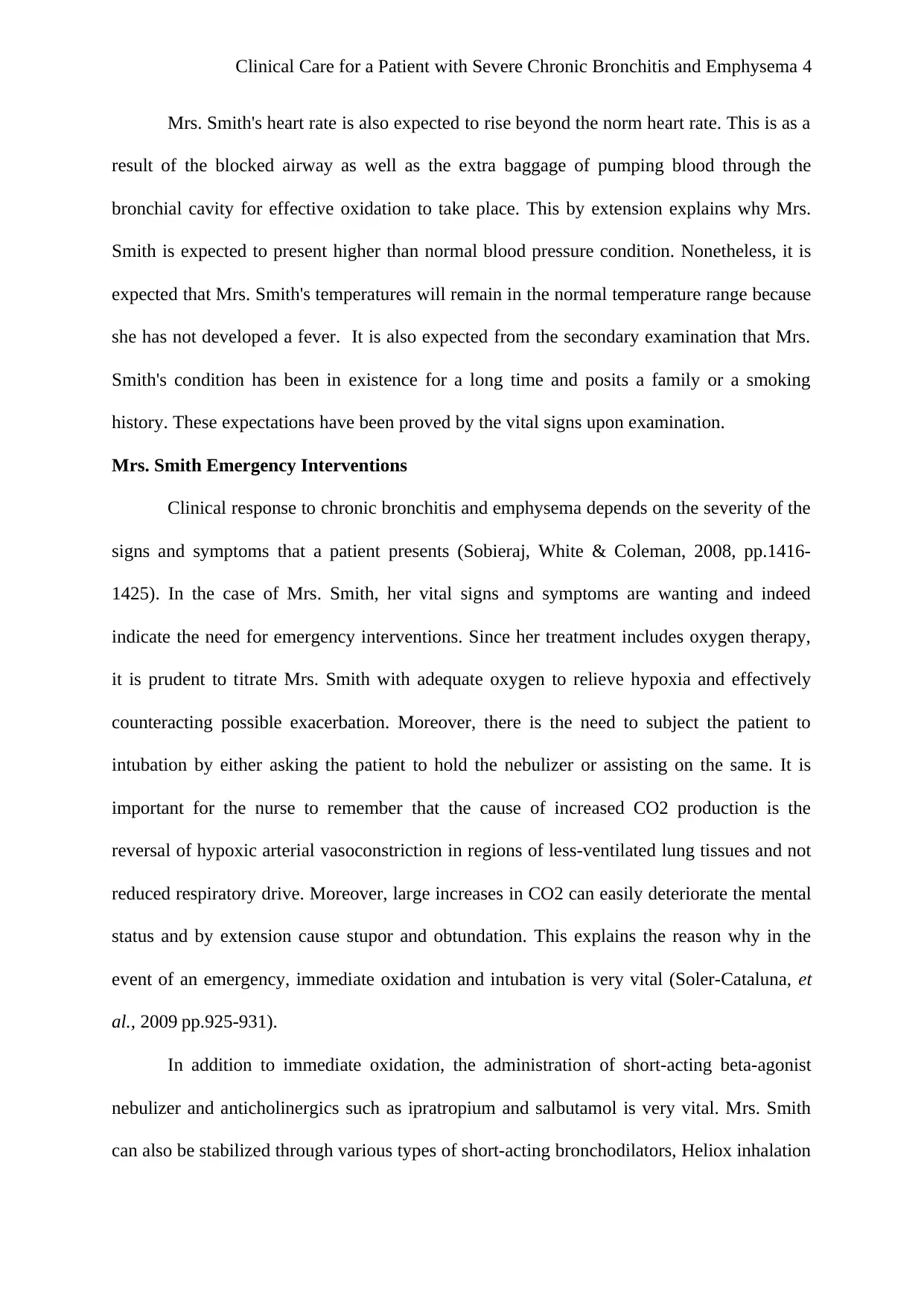
Clinical Care for a Patient with Severe Chronic Bronchitis and Emphysema 4
Mrs. Smith's heart rate is also expected to rise beyond the norm heart rate. This is as a
result of the blocked airway as well as the extra baggage of pumping blood through the
bronchial cavity for effective oxidation to take place. This by extension explains why Mrs.
Smith is expected to present higher than normal blood pressure condition. Nonetheless, it is
expected that Mrs. Smith's temperatures will remain in the normal temperature range because
she has not developed a fever. It is also expected from the secondary examination that Mrs.
Smith's condition has been in existence for a long time and posits a family or a smoking
history. These expectations have been proved by the vital signs upon examination.
Mrs. Smith Emergency Interventions
Clinical response to chronic bronchitis and emphysema depends on the severity of the
signs and symptoms that a patient presents (Sobieraj, White & Coleman, 2008, pp.1416-
1425). In the case of Mrs. Smith, her vital signs and symptoms are wanting and indeed
indicate the need for emergency interventions. Since her treatment includes oxygen therapy,
it is prudent to titrate Mrs. Smith with adequate oxygen to relieve hypoxia and effectively
counteracting possible exacerbation. Moreover, there is the need to subject the patient to
intubation by either asking the patient to hold the nebulizer or assisting on the same. It is
important for the nurse to remember that the cause of increased CO2 production is the
reversal of hypoxic arterial vasoconstriction in regions of less-ventilated lung tissues and not
reduced respiratory drive. Moreover, large increases in CO2 can easily deteriorate the mental
status and by extension cause stupor and obtundation. This explains the reason why in the
event of an emergency, immediate oxidation and intubation is very vital (Soler-Cataluna, et
al., 2009 pp.925-931).
In addition to immediate oxidation, the administration of short-acting beta-agonist
nebulizer and anticholinergics such as ipratropium and salbutamol is very vital. Mrs. Smith
can also be stabilized through various types of short-acting bronchodilators, Heliox inhalation
Mrs. Smith's heart rate is also expected to rise beyond the norm heart rate. This is as a
result of the blocked airway as well as the extra baggage of pumping blood through the
bronchial cavity for effective oxidation to take place. This by extension explains why Mrs.
Smith is expected to present higher than normal blood pressure condition. Nonetheless, it is
expected that Mrs. Smith's temperatures will remain in the normal temperature range because
she has not developed a fever. It is also expected from the secondary examination that Mrs.
Smith's condition has been in existence for a long time and posits a family or a smoking
history. These expectations have been proved by the vital signs upon examination.
Mrs. Smith Emergency Interventions
Clinical response to chronic bronchitis and emphysema depends on the severity of the
signs and symptoms that a patient presents (Sobieraj, White & Coleman, 2008, pp.1416-
1425). In the case of Mrs. Smith, her vital signs and symptoms are wanting and indeed
indicate the need for emergency interventions. Since her treatment includes oxygen therapy,
it is prudent to titrate Mrs. Smith with adequate oxygen to relieve hypoxia and effectively
counteracting possible exacerbation. Moreover, there is the need to subject the patient to
intubation by either asking the patient to hold the nebulizer or assisting on the same. It is
important for the nurse to remember that the cause of increased CO2 production is the
reversal of hypoxic arterial vasoconstriction in regions of less-ventilated lung tissues and not
reduced respiratory drive. Moreover, large increases in CO2 can easily deteriorate the mental
status and by extension cause stupor and obtundation. This explains the reason why in the
event of an emergency, immediate oxidation and intubation is very vital (Soler-Cataluna, et
al., 2009 pp.925-931).
In addition to immediate oxidation, the administration of short-acting beta-agonist
nebulizer and anticholinergics such as ipratropium and salbutamol is very vital. Mrs. Smith
can also be stabilized through various types of short-acting bronchodilators, Heliox inhalation
Paraphrase This Document
Need a fresh take? Get an instant paraphrase of this document with our AI Paraphraser
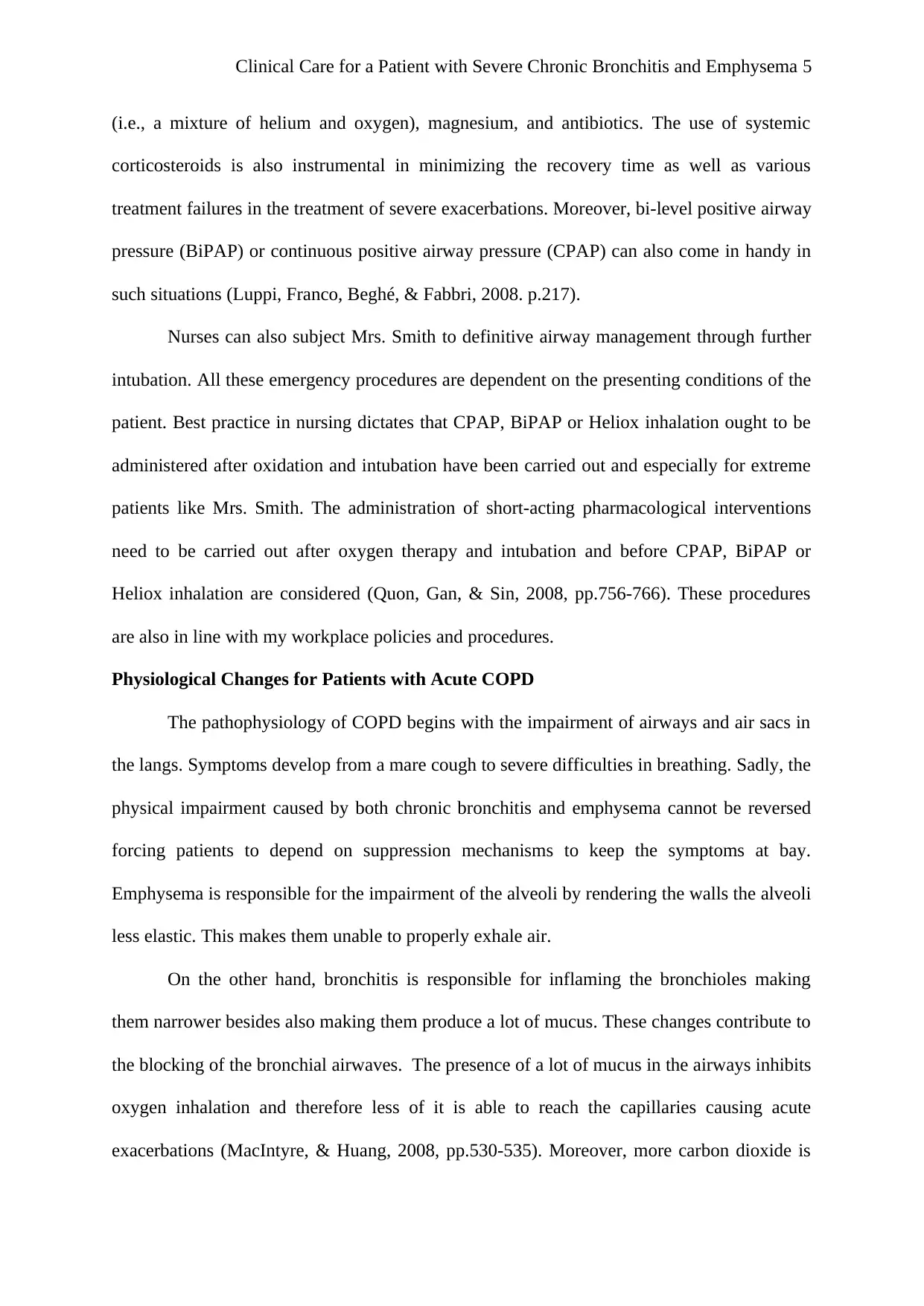
Clinical Care for a Patient with Severe Chronic Bronchitis and Emphysema 5
(i.e., a mixture of helium and oxygen), magnesium, and antibiotics. The use of systemic
corticosteroids is also instrumental in minimizing the recovery time as well as various
treatment failures in the treatment of severe exacerbations. Moreover, bi-level positive airway
pressure (BiPAP) or continuous positive airway pressure (CPAP) can also come in handy in
such situations (Luppi, Franco, Beghé, & Fabbri, 2008. p.217).
Nurses can also subject Mrs. Smith to definitive airway management through further
intubation. All these emergency procedures are dependent on the presenting conditions of the
patient. Best practice in nursing dictates that CPAP, BiPAP or Heliox inhalation ought to be
administered after oxidation and intubation have been carried out and especially for extreme
patients like Mrs. Smith. The administration of short-acting pharmacological interventions
need to be carried out after oxygen therapy and intubation and before CPAP, BiPAP or
Heliox inhalation are considered (Quon, Gan, & Sin, 2008, pp.756-766). These procedures
are also in line with my workplace policies and procedures.
Physiological Changes for Patients with Acute COPD
The pathophysiology of COPD begins with the impairment of airways and air sacs in
the langs. Symptoms develop from a mare cough to severe difficulties in breathing. Sadly, the
physical impairment caused by both chronic bronchitis and emphysema cannot be reversed
forcing patients to depend on suppression mechanisms to keep the symptoms at bay.
Emphysema is responsible for the impairment of the alveoli by rendering the walls the alveoli
less elastic. This makes them unable to properly exhale air.
On the other hand, bronchitis is responsible for inflaming the bronchioles making
them narrower besides also making them produce a lot of mucus. These changes contribute to
the blocking of the bronchial airwaves. The presence of a lot of mucus in the airways inhibits
oxygen inhalation and therefore less of it is able to reach the capillaries causing acute
exacerbations (MacIntyre, & Huang, 2008, pp.530-535). Moreover, more carbon dioxide is
(i.e., a mixture of helium and oxygen), magnesium, and antibiotics. The use of systemic
corticosteroids is also instrumental in minimizing the recovery time as well as various
treatment failures in the treatment of severe exacerbations. Moreover, bi-level positive airway
pressure (BiPAP) or continuous positive airway pressure (CPAP) can also come in handy in
such situations (Luppi, Franco, Beghé, & Fabbri, 2008. p.217).
Nurses can also subject Mrs. Smith to definitive airway management through further
intubation. All these emergency procedures are dependent on the presenting conditions of the
patient. Best practice in nursing dictates that CPAP, BiPAP or Heliox inhalation ought to be
administered after oxidation and intubation have been carried out and especially for extreme
patients like Mrs. Smith. The administration of short-acting pharmacological interventions
need to be carried out after oxygen therapy and intubation and before CPAP, BiPAP or
Heliox inhalation are considered (Quon, Gan, & Sin, 2008, pp.756-766). These procedures
are also in line with my workplace policies and procedures.
Physiological Changes for Patients with Acute COPD
The pathophysiology of COPD begins with the impairment of airways and air sacs in
the langs. Symptoms develop from a mare cough to severe difficulties in breathing. Sadly, the
physical impairment caused by both chronic bronchitis and emphysema cannot be reversed
forcing patients to depend on suppression mechanisms to keep the symptoms at bay.
Emphysema is responsible for the impairment of the alveoli by rendering the walls the alveoli
less elastic. This makes them unable to properly exhale air.
On the other hand, bronchitis is responsible for inflaming the bronchioles making
them narrower besides also making them produce a lot of mucus. These changes contribute to
the blocking of the bronchial airwaves. The presence of a lot of mucus in the airways inhibits
oxygen inhalation and therefore less of it is able to reach the capillaries causing acute
exacerbations (MacIntyre, & Huang, 2008, pp.530-535). Moreover, more carbon dioxide is
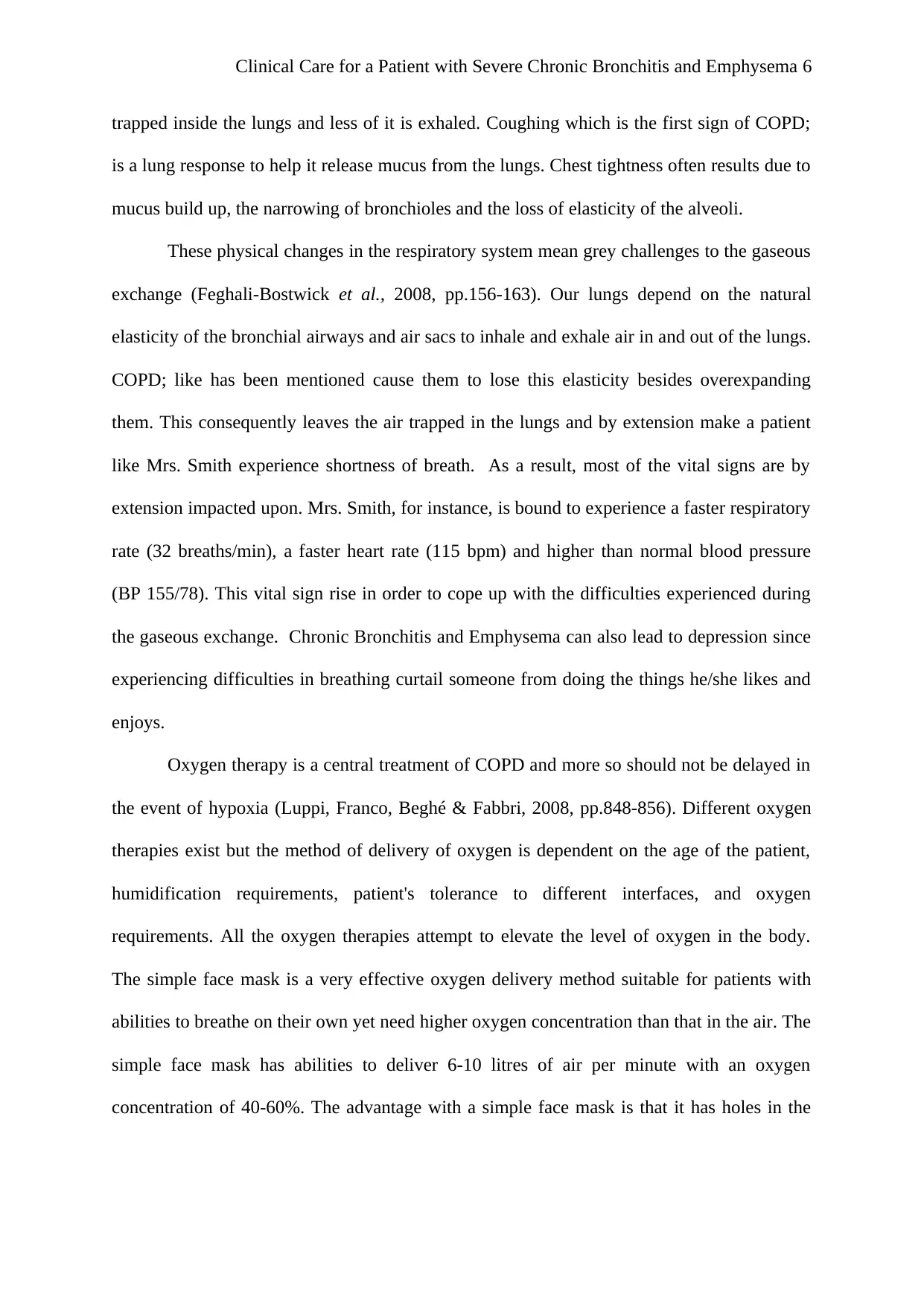
Clinical Care for a Patient with Severe Chronic Bronchitis and Emphysema 6
trapped inside the lungs and less of it is exhaled. Coughing which is the first sign of COPD;
is a lung response to help it release mucus from the lungs. Chest tightness often results due to
mucus build up, the narrowing of bronchioles and the loss of elasticity of the alveoli.
These physical changes in the respiratory system mean grey challenges to the gaseous
exchange (Feghali-Bostwick et al., 2008, pp.156-163). Our lungs depend on the natural
elasticity of the bronchial airways and air sacs to inhale and exhale air in and out of the lungs.
COPD; like has been mentioned cause them to lose this elasticity besides overexpanding
them. This consequently leaves the air trapped in the lungs and by extension make a patient
like Mrs. Smith experience shortness of breath. As a result, most of the vital signs are by
extension impacted upon. Mrs. Smith, for instance, is bound to experience a faster respiratory
rate (32 breaths/min), a faster heart rate (115 bpm) and higher than normal blood pressure
(BP 155/78). This vital sign rise in order to cope up with the difficulties experienced during
the gaseous exchange. Chronic Bronchitis and Emphysema can also lead to depression since
experiencing difficulties in breathing curtail someone from doing the things he/she likes and
enjoys.
Oxygen therapy is a central treatment of COPD and more so should not be delayed in
the event of hypoxia (Luppi, Franco, Beghé & Fabbri, 2008, pp.848-856). Different oxygen
therapies exist but the method of delivery of oxygen is dependent on the age of the patient,
humidification requirements, patient's tolerance to different interfaces, and oxygen
requirements. All the oxygen therapies attempt to elevate the level of oxygen in the body.
The simple face mask is a very effective oxygen delivery method suitable for patients with
abilities to breathe on their own yet need higher oxygen concentration than that in the air. The
simple face mask has abilities to deliver 6-10 litres of air per minute with an oxygen
concentration of 40-60%. The advantage with a simple face mask is that it has holes in the
trapped inside the lungs and less of it is exhaled. Coughing which is the first sign of COPD;
is a lung response to help it release mucus from the lungs. Chest tightness often results due to
mucus build up, the narrowing of bronchioles and the loss of elasticity of the alveoli.
These physical changes in the respiratory system mean grey challenges to the gaseous
exchange (Feghali-Bostwick et al., 2008, pp.156-163). Our lungs depend on the natural
elasticity of the bronchial airways and air sacs to inhale and exhale air in and out of the lungs.
COPD; like has been mentioned cause them to lose this elasticity besides overexpanding
them. This consequently leaves the air trapped in the lungs and by extension make a patient
like Mrs. Smith experience shortness of breath. As a result, most of the vital signs are by
extension impacted upon. Mrs. Smith, for instance, is bound to experience a faster respiratory
rate (32 breaths/min), a faster heart rate (115 bpm) and higher than normal blood pressure
(BP 155/78). This vital sign rise in order to cope up with the difficulties experienced during
the gaseous exchange. Chronic Bronchitis and Emphysema can also lead to depression since
experiencing difficulties in breathing curtail someone from doing the things he/she likes and
enjoys.
Oxygen therapy is a central treatment of COPD and more so should not be delayed in
the event of hypoxia (Luppi, Franco, Beghé & Fabbri, 2008, pp.848-856). Different oxygen
therapies exist but the method of delivery of oxygen is dependent on the age of the patient,
humidification requirements, patient's tolerance to different interfaces, and oxygen
requirements. All the oxygen therapies attempt to elevate the level of oxygen in the body.
The simple face mask is a very effective oxygen delivery method suitable for patients with
abilities to breathe on their own yet need higher oxygen concentration than that in the air. The
simple face mask has abilities to deliver 6-10 litres of air per minute with an oxygen
concentration of 40-60%. The advantage with a simple face mask is that it has holes in the
⊘ This is a preview!⊘
Do you want full access?
Subscribe today to unlock all pages.

Trusted by 1+ million students worldwide
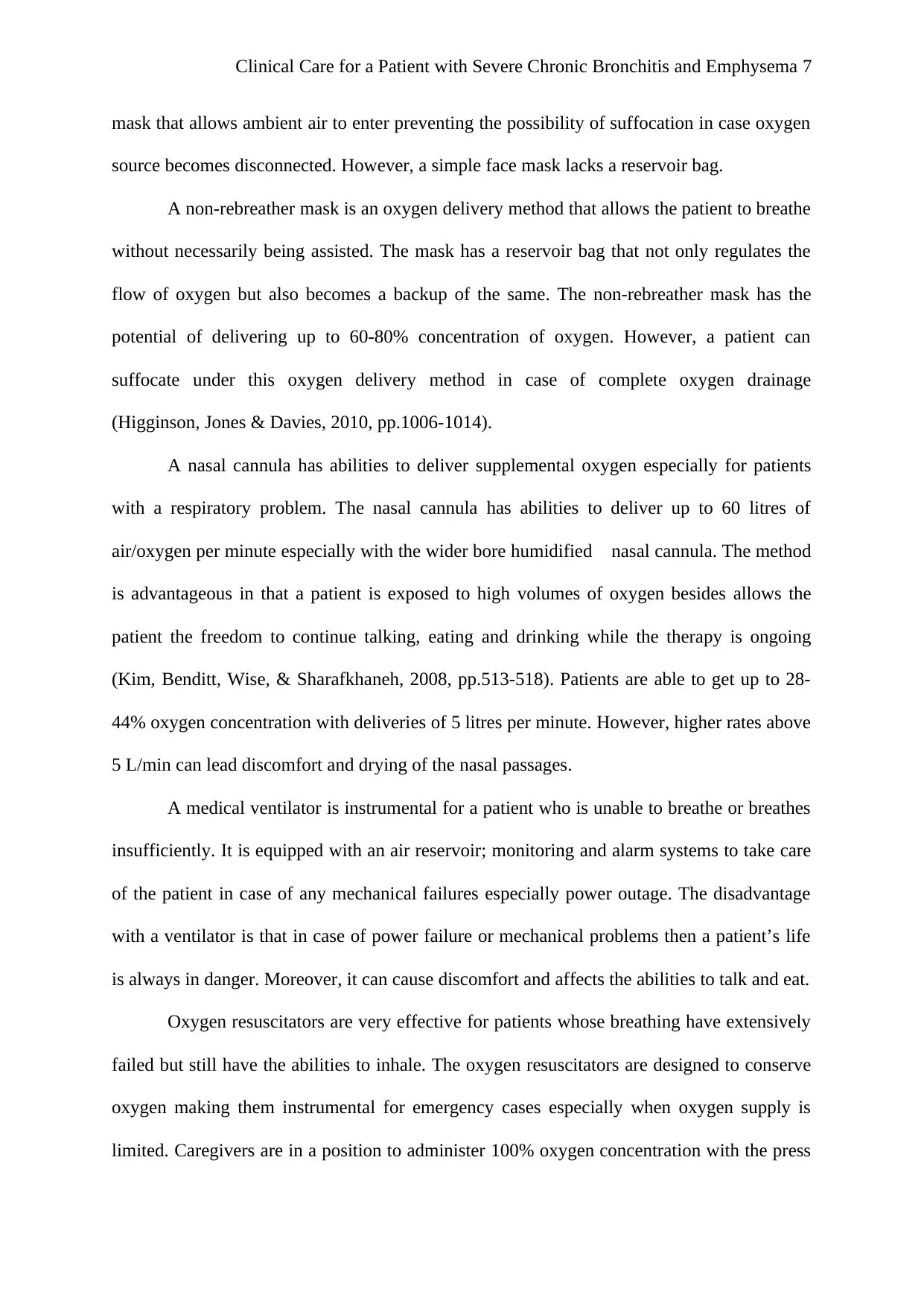
Clinical Care for a Patient with Severe Chronic Bronchitis and Emphysema 7
mask that allows ambient air to enter preventing the possibility of suffocation in case oxygen
source becomes disconnected. However, a simple face mask lacks a reservoir bag.
A non-rebreather mask is an oxygen delivery method that allows the patient to breathe
without necessarily being assisted. The mask has a reservoir bag that not only regulates the
flow of oxygen but also becomes a backup of the same. The non-rebreather mask has the
potential of delivering up to 60-80% concentration of oxygen. However, a patient can
suffocate under this oxygen delivery method in case of complete oxygen drainage
(Higginson, Jones & Davies, 2010, pp.1006-1014).
A nasal cannula has abilities to deliver supplemental oxygen especially for patients
with a respiratory problem. The nasal cannula has abilities to deliver up to 60 litres of
air/oxygen per minute especially with the wider bore humidified nasal cannula. The method
is advantageous in that a patient is exposed to high volumes of oxygen besides allows the
patient the freedom to continue talking, eating and drinking while the therapy is ongoing
(Kim, Benditt, Wise, & Sharafkhaneh, 2008, pp.513-518). Patients are able to get up to 28-
44% oxygen concentration with deliveries of 5 litres per minute. However, higher rates above
5 L/min can lead discomfort and drying of the nasal passages.
A medical ventilator is instrumental for a patient who is unable to breathe or breathes
insufficiently. It is equipped with an air reservoir; monitoring and alarm systems to take care
of the patient in case of any mechanical failures especially power outage. The disadvantage
with a ventilator is that in case of power failure or mechanical problems then a patient’s life
is always in danger. Moreover, it can cause discomfort and affects the abilities to talk and eat.
Oxygen resuscitators are very effective for patients whose breathing have extensively
failed but still have the abilities to inhale. The oxygen resuscitators are designed to conserve
oxygen making them instrumental for emergency cases especially when oxygen supply is
limited. Caregivers are in a position to administer 100% oxygen concentration with the press
mask that allows ambient air to enter preventing the possibility of suffocation in case oxygen
source becomes disconnected. However, a simple face mask lacks a reservoir bag.
A non-rebreather mask is an oxygen delivery method that allows the patient to breathe
without necessarily being assisted. The mask has a reservoir bag that not only regulates the
flow of oxygen but also becomes a backup of the same. The non-rebreather mask has the
potential of delivering up to 60-80% concentration of oxygen. However, a patient can
suffocate under this oxygen delivery method in case of complete oxygen drainage
(Higginson, Jones & Davies, 2010, pp.1006-1014).
A nasal cannula has abilities to deliver supplemental oxygen especially for patients
with a respiratory problem. The nasal cannula has abilities to deliver up to 60 litres of
air/oxygen per minute especially with the wider bore humidified nasal cannula. The method
is advantageous in that a patient is exposed to high volumes of oxygen besides allows the
patient the freedom to continue talking, eating and drinking while the therapy is ongoing
(Kim, Benditt, Wise, & Sharafkhaneh, 2008, pp.513-518). Patients are able to get up to 28-
44% oxygen concentration with deliveries of 5 litres per minute. However, higher rates above
5 L/min can lead discomfort and drying of the nasal passages.
A medical ventilator is instrumental for a patient who is unable to breathe or breathes
insufficiently. It is equipped with an air reservoir; monitoring and alarm systems to take care
of the patient in case of any mechanical failures especially power outage. The disadvantage
with a ventilator is that in case of power failure or mechanical problems then a patient’s life
is always in danger. Moreover, it can cause discomfort and affects the abilities to talk and eat.
Oxygen resuscitators are very effective for patients whose breathing have extensively
failed but still have the abilities to inhale. The oxygen resuscitators are designed to conserve
oxygen making them instrumental for emergency cases especially when oxygen supply is
limited. Caregivers are in a position to administer 100% oxygen concentration with the press
Paraphrase This Document
Need a fresh take? Get an instant paraphrase of this document with our AI Paraphraser
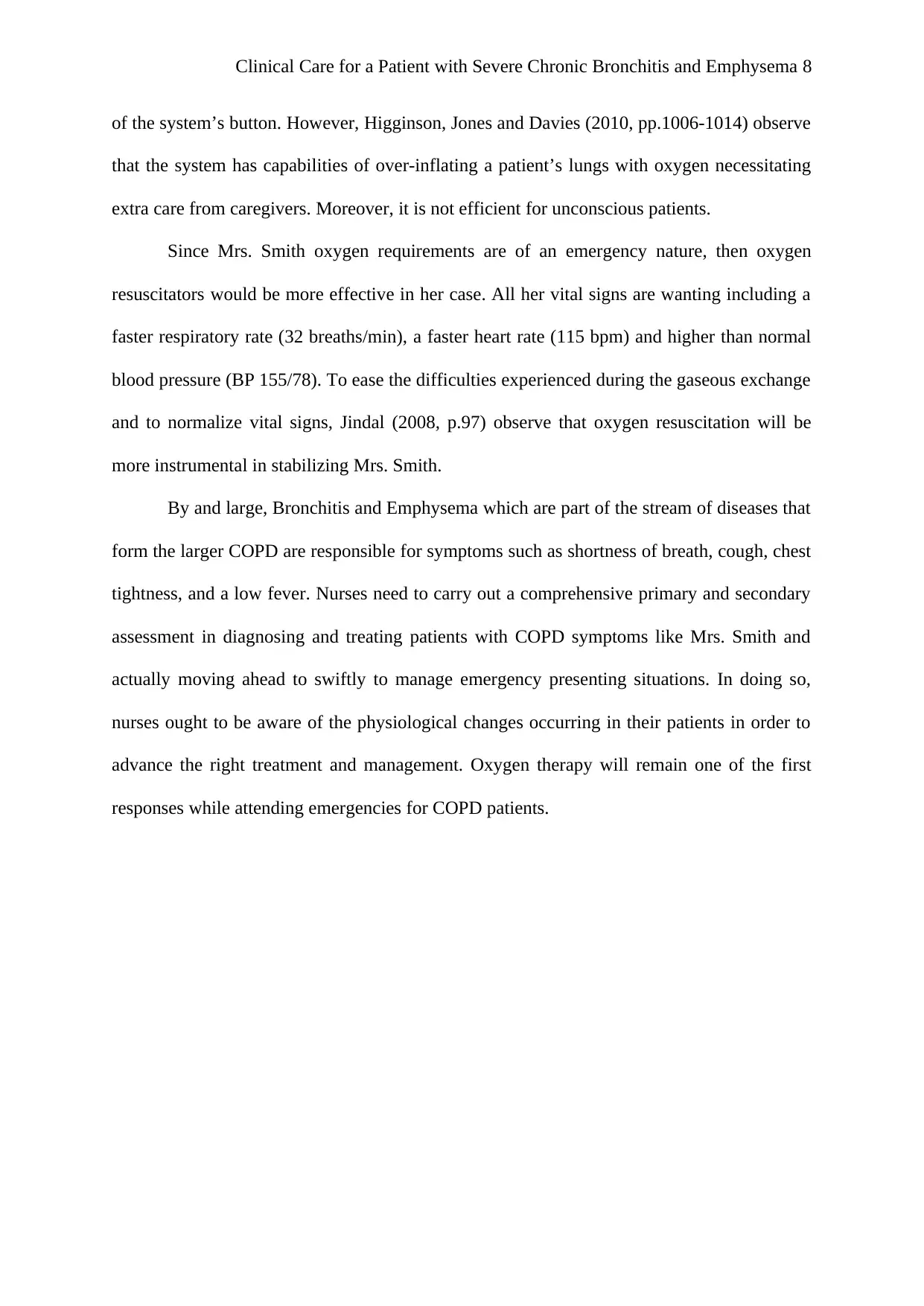
Clinical Care for a Patient with Severe Chronic Bronchitis and Emphysema 8
of the system’s button. However, Higginson, Jones and Davies (2010, pp.1006-1014) observe
that the system has capabilities of over-inflating a patient’s lungs with oxygen necessitating
extra care from caregivers. Moreover, it is not efficient for unconscious patients.
Since Mrs. Smith oxygen requirements are of an emergency nature, then oxygen
resuscitators would be more effective in her case. All her vital signs are wanting including a
faster respiratory rate (32 breaths/min), a faster heart rate (115 bpm) and higher than normal
blood pressure (BP 155/78). To ease the difficulties experienced during the gaseous exchange
and to normalize vital signs, Jindal (2008, p.97) observe that oxygen resuscitation will be
more instrumental in stabilizing Mrs. Smith.
By and large, Bronchitis and Emphysema which are part of the stream of diseases that
form the larger COPD are responsible for symptoms such as shortness of breath, cough, chest
tightness, and a low fever. Nurses need to carry out a comprehensive primary and secondary
assessment in diagnosing and treating patients with COPD symptoms like Mrs. Smith and
actually moving ahead to swiftly to manage emergency presenting situations. In doing so,
nurses ought to be aware of the physiological changes occurring in their patients in order to
advance the right treatment and management. Oxygen therapy will remain one of the first
responses while attending emergencies for COPD patients.
of the system’s button. However, Higginson, Jones and Davies (2010, pp.1006-1014) observe
that the system has capabilities of over-inflating a patient’s lungs with oxygen necessitating
extra care from caregivers. Moreover, it is not efficient for unconscious patients.
Since Mrs. Smith oxygen requirements are of an emergency nature, then oxygen
resuscitators would be more effective in her case. All her vital signs are wanting including a
faster respiratory rate (32 breaths/min), a faster heart rate (115 bpm) and higher than normal
blood pressure (BP 155/78). To ease the difficulties experienced during the gaseous exchange
and to normalize vital signs, Jindal (2008, p.97) observe that oxygen resuscitation will be
more instrumental in stabilizing Mrs. Smith.
By and large, Bronchitis and Emphysema which are part of the stream of diseases that
form the larger COPD are responsible for symptoms such as shortness of breath, cough, chest
tightness, and a low fever. Nurses need to carry out a comprehensive primary and secondary
assessment in diagnosing and treating patients with COPD symptoms like Mrs. Smith and
actually moving ahead to swiftly to manage emergency presenting situations. In doing so,
nurses ought to be aware of the physiological changes occurring in their patients in order to
advance the right treatment and management. Oxygen therapy will remain one of the first
responses while attending emergencies for COPD patients.
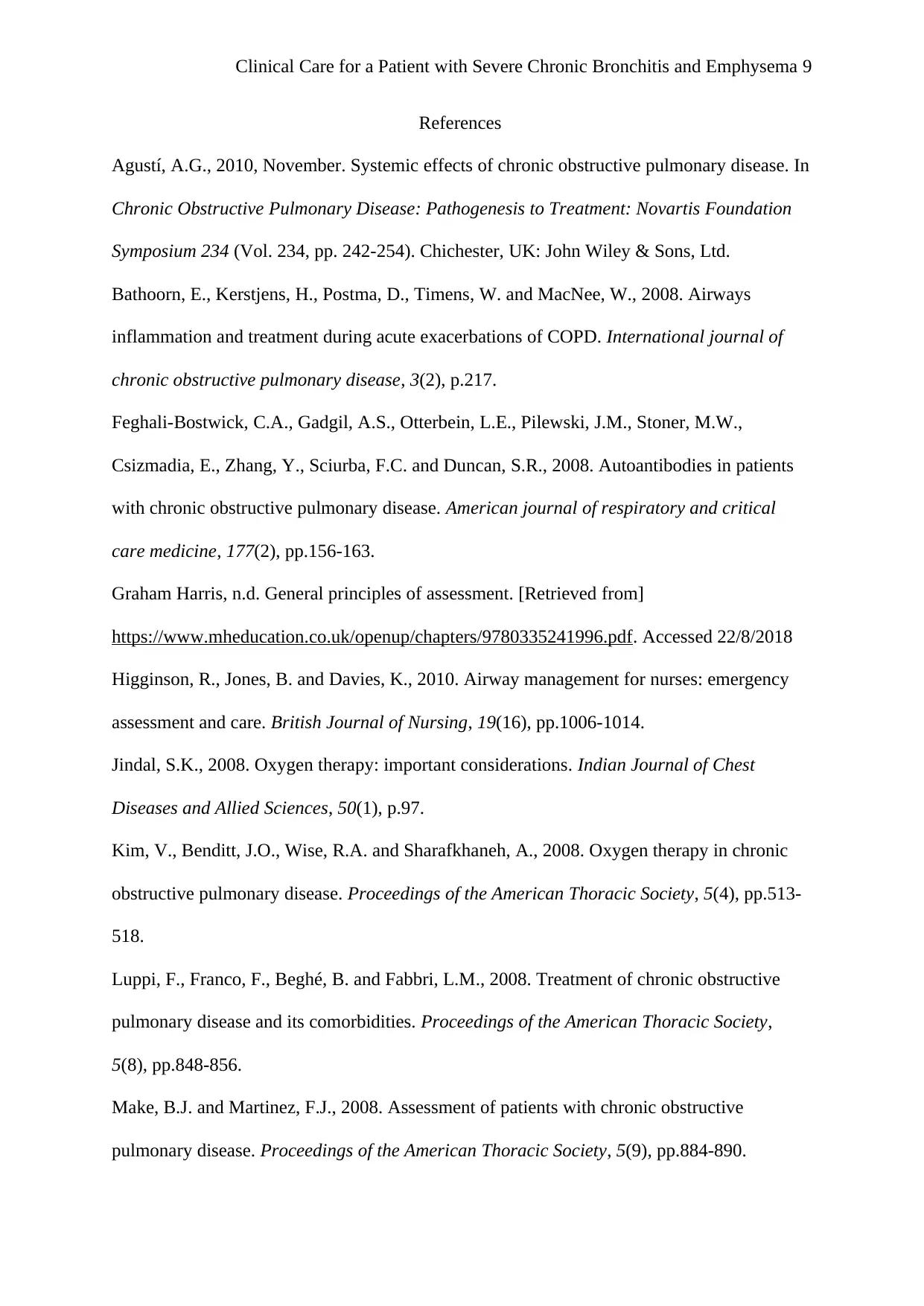
Clinical Care for a Patient with Severe Chronic Bronchitis and Emphysema 9
References
Agustí, A.G., 2010, November. Systemic effects of chronic obstructive pulmonary disease. In
Chronic Obstructive Pulmonary Disease: Pathogenesis to Treatment: Novartis Foundation
Symposium 234 (Vol. 234, pp. 242-254). Chichester, UK: John Wiley & Sons, Ltd.
Bathoorn, E., Kerstjens, H., Postma, D., Timens, W. and MacNee, W., 2008. Airways
inflammation and treatment during acute exacerbations of COPD. International journal of
chronic obstructive pulmonary disease, 3(2), p.217.
Feghali-Bostwick, C.A., Gadgil, A.S., Otterbein, L.E., Pilewski, J.M., Stoner, M.W.,
Csizmadia, E., Zhang, Y., Sciurba, F.C. and Duncan, S.R., 2008. Autoantibodies in patients
with chronic obstructive pulmonary disease. American journal of respiratory and critical
care medicine, 177(2), pp.156-163.
Graham Harris, n.d. General principles of assessment. [Retrieved from]
https://www.mheducation.co.uk/openup/chapters/9780335241996.pdf. Accessed 22/8/2018
Higginson, R., Jones, B. and Davies, K., 2010. Airway management for nurses: emergency
assessment and care. British Journal of Nursing, 19(16), pp.1006-1014.
Jindal, S.K., 2008. Oxygen therapy: important considerations. Indian Journal of Chest
Diseases and Allied Sciences, 50(1), p.97.
Kim, V., Benditt, J.O., Wise, R.A. and Sharafkhaneh, A., 2008. Oxygen therapy in chronic
obstructive pulmonary disease. Proceedings of the American Thoracic Society, 5(4), pp.513-
518.
Luppi, F., Franco, F., Beghé, B. and Fabbri, L.M., 2008. Treatment of chronic obstructive
pulmonary disease and its comorbidities. Proceedings of the American Thoracic Society,
5(8), pp.848-856.
Make, B.J. and Martinez, F.J., 2008. Assessment of patients with chronic obstructive
pulmonary disease. Proceedings of the American Thoracic Society, 5(9), pp.884-890.
References
Agustí, A.G., 2010, November. Systemic effects of chronic obstructive pulmonary disease. In
Chronic Obstructive Pulmonary Disease: Pathogenesis to Treatment: Novartis Foundation
Symposium 234 (Vol. 234, pp. 242-254). Chichester, UK: John Wiley & Sons, Ltd.
Bathoorn, E., Kerstjens, H., Postma, D., Timens, W. and MacNee, W., 2008. Airways
inflammation and treatment during acute exacerbations of COPD. International journal of
chronic obstructive pulmonary disease, 3(2), p.217.
Feghali-Bostwick, C.A., Gadgil, A.S., Otterbein, L.E., Pilewski, J.M., Stoner, M.W.,
Csizmadia, E., Zhang, Y., Sciurba, F.C. and Duncan, S.R., 2008. Autoantibodies in patients
with chronic obstructive pulmonary disease. American journal of respiratory and critical
care medicine, 177(2), pp.156-163.
Graham Harris, n.d. General principles of assessment. [Retrieved from]
https://www.mheducation.co.uk/openup/chapters/9780335241996.pdf. Accessed 22/8/2018
Higginson, R., Jones, B. and Davies, K., 2010. Airway management for nurses: emergency
assessment and care. British Journal of Nursing, 19(16), pp.1006-1014.
Jindal, S.K., 2008. Oxygen therapy: important considerations. Indian Journal of Chest
Diseases and Allied Sciences, 50(1), p.97.
Kim, V., Benditt, J.O., Wise, R.A. and Sharafkhaneh, A., 2008. Oxygen therapy in chronic
obstructive pulmonary disease. Proceedings of the American Thoracic Society, 5(4), pp.513-
518.
Luppi, F., Franco, F., Beghé, B. and Fabbri, L.M., 2008. Treatment of chronic obstructive
pulmonary disease and its comorbidities. Proceedings of the American Thoracic Society,
5(8), pp.848-856.
Make, B.J. and Martinez, F.J., 2008. Assessment of patients with chronic obstructive
pulmonary disease. Proceedings of the American Thoracic Society, 5(9), pp.884-890.
⊘ This is a preview!⊘
Do you want full access?
Subscribe today to unlock all pages.

Trusted by 1+ million students worldwide
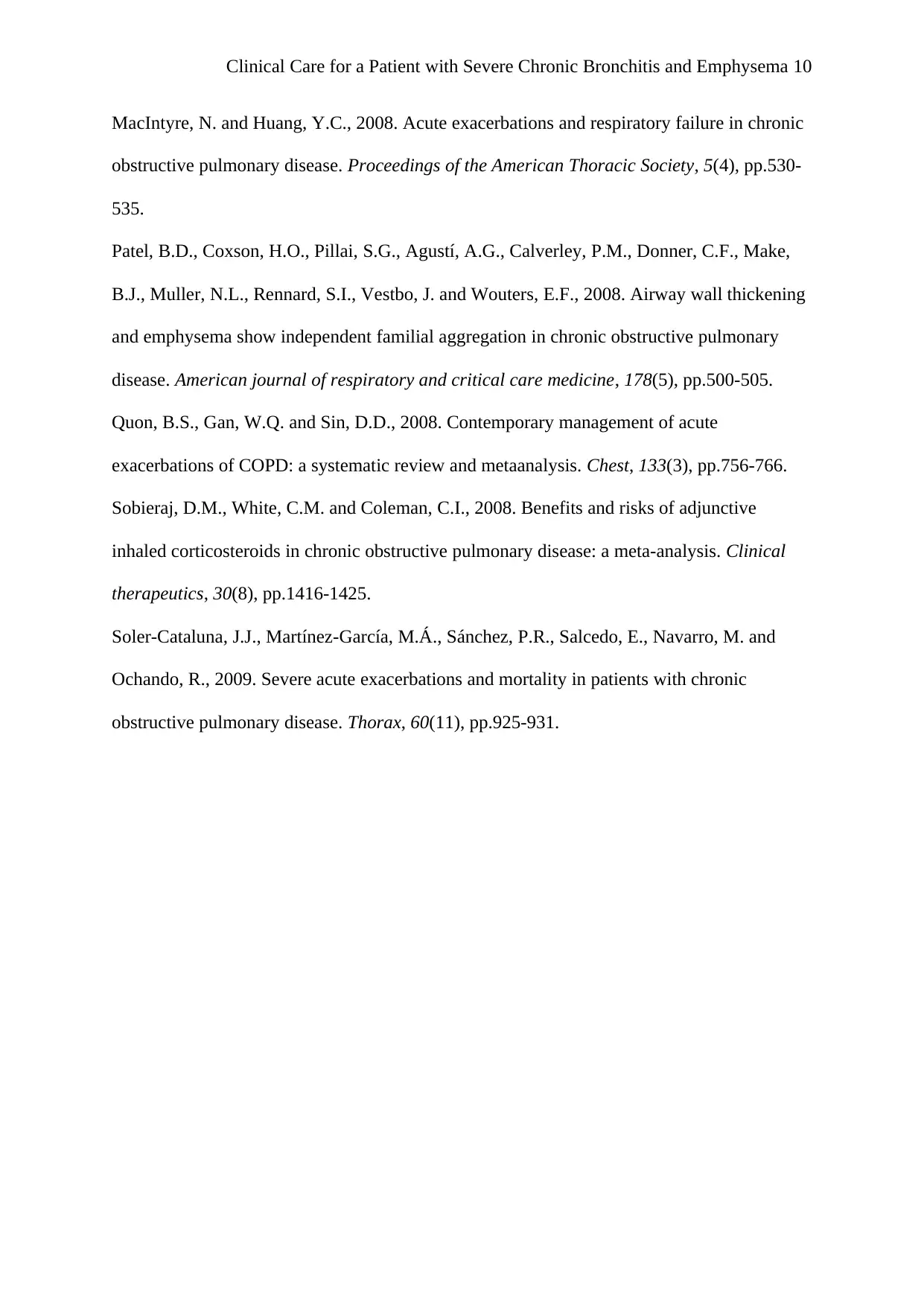
Clinical Care for a Patient with Severe Chronic Bronchitis and Emphysema 10
MacIntyre, N. and Huang, Y.C., 2008. Acute exacerbations and respiratory failure in chronic
obstructive pulmonary disease. Proceedings of the American Thoracic Society, 5(4), pp.530-
535.
Patel, B.D., Coxson, H.O., Pillai, S.G., Agustí, A.G., Calverley, P.M., Donner, C.F., Make,
B.J., Muller, N.L., Rennard, S.I., Vestbo, J. and Wouters, E.F., 2008. Airway wall thickening
and emphysema show independent familial aggregation in chronic obstructive pulmonary
disease. American journal of respiratory and critical care medicine, 178(5), pp.500-505.
Quon, B.S., Gan, W.Q. and Sin, D.D., 2008. Contemporary management of acute
exacerbations of COPD: a systematic review and metaanalysis. Chest, 133(3), pp.756-766.
Sobieraj, D.M., White, C.M. and Coleman, C.I., 2008. Benefits and risks of adjunctive
inhaled corticosteroids in chronic obstructive pulmonary disease: a meta-analysis. Clinical
therapeutics, 30(8), pp.1416-1425.
Soler-Cataluna, J.J., Martínez-García, M.Á., Sánchez, P.R., Salcedo, E., Navarro, M. and
Ochando, R., 2009. Severe acute exacerbations and mortality in patients with chronic
obstructive pulmonary disease. Thorax, 60(11), pp.925-931.
MacIntyre, N. and Huang, Y.C., 2008. Acute exacerbations and respiratory failure in chronic
obstructive pulmonary disease. Proceedings of the American Thoracic Society, 5(4), pp.530-
535.
Patel, B.D., Coxson, H.O., Pillai, S.G., Agustí, A.G., Calverley, P.M., Donner, C.F., Make,
B.J., Muller, N.L., Rennard, S.I., Vestbo, J. and Wouters, E.F., 2008. Airway wall thickening
and emphysema show independent familial aggregation in chronic obstructive pulmonary
disease. American journal of respiratory and critical care medicine, 178(5), pp.500-505.
Quon, B.S., Gan, W.Q. and Sin, D.D., 2008. Contemporary management of acute
exacerbations of COPD: a systematic review and metaanalysis. Chest, 133(3), pp.756-766.
Sobieraj, D.M., White, C.M. and Coleman, C.I., 2008. Benefits and risks of adjunctive
inhaled corticosteroids in chronic obstructive pulmonary disease: a meta-analysis. Clinical
therapeutics, 30(8), pp.1416-1425.
Soler-Cataluna, J.J., Martínez-García, M.Á., Sánchez, P.R., Salcedo, E., Navarro, M. and
Ochando, R., 2009. Severe acute exacerbations and mortality in patients with chronic
obstructive pulmonary disease. Thorax, 60(11), pp.925-931.
1 out of 10
Related Documents
Your All-in-One AI-Powered Toolkit for Academic Success.
+13062052269
info@desklib.com
Available 24*7 on WhatsApp / Email
![[object Object]](/_next/static/media/star-bottom.7253800d.svg)
Unlock your academic potential
Copyright © 2020–2025 A2Z Services. All Rights Reserved. Developed and managed by ZUCOL.





